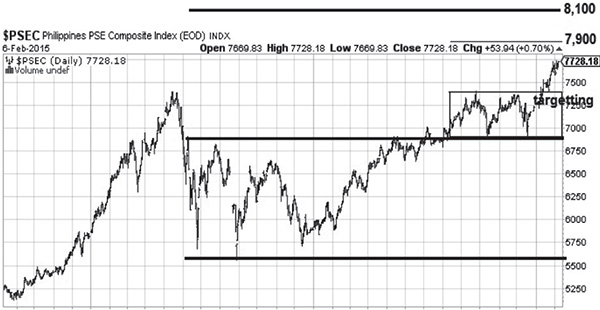Philippine stock market: The outperformer
The Philippine stock market continues its record run as it enters the 7th year of its secular bull market. Since bottoming out in 2008-2009, the PSE index has been one of the best performing in the world, gaining more than 350 percent. This year, we at Philequity, expect the PSE index to continue outperforming as it tries to scale above the 8,000 level for the first time.
A standout in the global economic environment
The Philippine economy stands out in a global economic environment of “slow and uneven” growth. The IMF recently raised its Philippine growth forecast while cutting the global outlook, saying the country will get a boost from higher public spending and lower oil prices.
In its recent World Economic Outlook update dated January 2015, the IMF expressed concern over the marked growth divergences across major economies. Among developed economies, only the US rebounded ahead of expectations while economic performance in Japan and Europe fell short of expectations.
Among emerging markets, growth is expected to be lower in China while downward revisions are expected in commodity exporters such as Russia and members of OPEC. This highlights the Philippine economy which the IMF expects to grow by 6.6 percent in 2015 and 6.4 percent in 2016.
CBs continue to flood the global economy with liquidity
With the exception of the US and Asia, many countries continue to struggle with their respective economies and are still on the easing path. While the US is preparing to tighten its noose on monetary policy this year, other central banks have taken the cudgels in order to spur their own respective economies.
Since the start of the year, many central banks have cut interest rates such as Australia, Canada, Russia, India, Peru, Pakistan, Singapore, Turkey and Egypt. In addition, the ECB launched its historic open-ended QE of 60 billion euros per month. Meanwhile, the People’s Bank of China cut its required bank reserves.
On the other hand, the benchmark Philippine rates are kept stable. The BSP continues to be in full control, has been proactive, and is holding policy rates steady.
Foreign funds are coming in
Being a standout in today’s “slow and uneven” growth environment makes the Philippines a major beneficiary of foreign funds looking for countries with growth. In January alone, net inflows to Philippine equities amounted to P22 billion which is already 40 percent of the P56 billion net inflows for the whole of 2014.
In addition, Philippine bonds continue to attract foreign capital despite historically low yields because of lack of alternatives when yields across the globe are near zero or negative.
The biggest winner
In previous articles we discussed in detail why the Philippines stands to gain the most as oil and commodity prices drops (see Cheaper commodity prices, a blessing for Filipino Consumers, Oct. 13, 2014, The Game Changer, Jan. 19, 2015 and Are low prices here to stay?, Jan. 26, 2015 ).
In a nutshell, the Philippines is projected to save between $4 billion to $6 billion annually if oil prices remain at $40-$60 per barrel. Prices of other commodities, including agricultural commodities, have likewise declined to their lowest since 2009.
The chart below shows the price of Brent crude oil and an Agriculture ETF (symbol: DBA).

Source: Stockcharts.com
The huge drop in crude oil and agricultural commodity prices should translate to higher domestic consumption as inflation drops and spending power rises. With 75 percent of the GDP coming from domestic consumption, the Philippines is clearly The Biggest Winner in this low oil and low commodity price environment.
Peso is stable
Meanwhile, the peso has remained relatively stable amid an environment of expanding currency volatility. In our article last week (see Philippine Peso: A Haven of Stability, Feb. 2, 2015), we showed that the peso even strengthened against the greenback for the month of January when major currencies suffered their steepest monthly decline. A stable peso coupled with low inflation and low interest rates should be good for business and good for stocks.
Targeting 8,000
What we are currently witnessing is a bull run in Philippine stocks. In just the first five weeks of 2015, the PSE index has rallied 6.88 percent. Since the run-up has been swift, corrections are expected and can happen anytime. However, technical analysis show that 7,900 to 8,100 is the next target for the PSE index (see chart below). Meanwhile, our year-end 2015 target based on 18x P/E 2016 is 8,200.
While nobody can tell when corrections will occur, we believe this bull market that started on March 6, 2009 is intact and will continue. We also believe that the price appreciations in many Philippine stocks are justified as we are in a secular bull market (see Secular Bull Market, Jan. 28, 2013).
We therefore continue to advise our readers to take advantage of pullbacks to get into the stock market through stocks or mutual funds. Another way is to purchase stocks or funds on a regular (weekly, monthly or quarterly) basis. This is called cost averaging. This has been our advice and overall strategy since this bull market started (see 666, March 23, 2009 and 666 on 3-6-9, April 13, 2009).

Source: Stockcharts.com
Philequity Management is the fund manager of the leading mutual funds in the Philippines. Visit www.philequity.net to learn more about Philequity’s managed funds or to view previous articles. For inquiries or to send feedback, please call (02) 689-8080 or email [email protected].
- Latest
- Trending



























